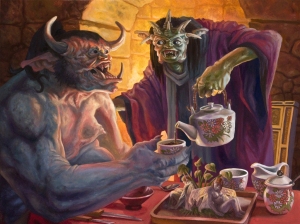DINING WITH THE DEAD
This
is where i have come to dine.
Postmortem hanging on the menu.
A plenipotentiary of the services of worms.
Hot chitter chatter
Of stern looking trolls pervades the enclave.
They belched after a meal of death.
Yawned and belched again, a fever in Yiddish.
Gazed at me, a clandestine intruder.
No chatter of humans, but muted conversations
Of mouthless ghosts.
Gastric acid running at the guts.
Then I knew it was the wrong company.
Postmortem hanging on the menu.
A plenipotentiary of the services of worms.
Hot chitter chatter
Of stern looking trolls pervades the enclave.
They belched after a meal of death.
Yawned and belched again, a fever in Yiddish.
Gazed at me, a clandestine intruder.
No chatter of humans, but muted conversations
Of mouthless ghosts.
Gastric acid running at the guts.
Then I knew it was the wrong company.

Troll Tea -- Sam Flegal
In “Gylfaginning,” the 1st part of Snorri Sturluson's 13th-century Prose Edda, the 11 icy rivers Élivágar (“Ice Waves”) which were so long “that the yeasty venom upon them had hardened like the slag that runs out of the fire, -- these then became ice; and when the ice halted and ceased to run, then it froze over above. But the drizzling rain that rose from the venom congealed to rime, and the rime increased, frost over frost, each over the other, even into Ginnungagap, the Yawning Void.” Ymir was born from the venom and asexually birthed a male and female from the pits of his arms, and a 6-headed being from his legs; these were the jötnar, a group which included the trolls. One of the jötnar was Bölþorn (“evil thorn” in Old Norse), his daughter Bestla was the mother of Óðinn, Vili and Vé, who slew Ymir and fashioned the Earth from his flesh, the ocean from his blood, the mountains from his bones. the trees from his hair, the clouds from his brains, the heavens from his skull, and Midhard, the realm of humans, from his eyebrows. Óðinn gave soul and life to the 1st humans Ask and Embla, Vili gave them wit (intelligence) and the sense of touch, and Vé gave them their appearance, speech, hearing, and sight. The surviving jötnar escaped by sailing through a flood of Ymir’s blood. They are often defined as giants, in particular the hrímþursar (frost giants), eldjötnar (fire giants), and bergrisar (mountain giants), they were usually depicted as roughly human sized; some were exceedingly beautiful or alarmingly grotesque, and some were animal-shaped. The 2nd part of the Prose Edda, the “Skáldskaparmál” (Language of Poetry), related an encounter between Bragi Boddason inn gamli (“the old”), the 1st skáld, who served several 9th-century Swedish kings, and an unnamed female troll who introduced herself thus: 'Trolls call me / moon of dwelling-Rungnir, / giant's wealth-sucker, / storm-sun's bale, / seeress's friendly companion, / guardian of corpse-fiord, / swallower of heaven-wheel; / what is a troll other than that?” (tr. Anthony Faulkes). In early accounts “tröll” and “jötunn" were synonyms
ReplyDeleteBut they gradually assumed different identities. Generally they dwelt in isolated rocks, mountains, burial mounds, or caves in small family units (usually as father and daughter or mother and son); some were ugly and slow-witted, frequently described as being extremely old and very strong, some were small, human-like beings, others were giants. In some accounts they were man-eaters, and they were associated with bergtagning (“mountain-taking,” i.e., kidnapping) and overrunning farms or estates. It was believed that they turned to stone upon contact with sunlight and were scared off by lightning and the tolling of church bells.